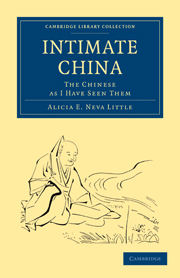Book contents
- Frontmatter
- Contents
- LIST OF ILLUSTRATIONS
- DRY STATEMENTS
- PRELUDE: FIRST IMPRESSIONS
- CHAPTER I ON THE UPPER YANGTSE
- CHAPTER II A LAND JOURNEY
- CHAPTER III LIFE IN A CHINESE CITY
- CHAPTER IV HINDRANCES AND ANNOYANCES
- CHAPTER V CURRENT COIN IN CHINA
- CHAPTER VI FOOTBINDING
- CHAPTER VII ANTI-FOOTBINDING
- CHAPTER VIII THE POSITION OF WOMEN
- CHAPTER IX BIRTHS, DEATHS, AND MARRIAGES
- CHAPTER X CHINESE MORALS
- CHAPTER XI SUPERSTITIONS
- CHAPTER XII OUR MISSIONARIES
- CHAPTER XIII UP-COUNTRY SHOPPING AND UP-COUNTRY WAYS
- CHAPTER XIV SOLDIERS
- CHAPTER XV CHINESE STUDENTS
- CHAPTER XVI A FATHER'S ADVICE TO HIS SON
- CHAPTER XVII BUDDHIST MONASTERIES
- CHAPTER XVIII A CHINESE ORDINATION
- CHAPTER XIX THE SACRED MOUNTAIN OF OMI
- CHAPTER XX CHINESE SENTIMENT
- CHAPTER XXI A SUMMER TRIP TO CHINESE TIBET
- CHAPTER XXII ARTS AND INDUSTRIES
- CHAPTER XXIII A LITTLE PEKING PUG
- PRELUDE: PART I.—GETTING TO PEKING and PART II.—THE SIGHTS OF PEKING
- CHAPTER I THE CHINESE EMPEROR'S MAGNIFICENCE
- CHAPTER II THE EMPRESS, THE EMPEROR, AND THE AUDIENCE
- CHAPTER III SOLIDARITY, CO-OPERATION, AND IMPERIAL FEDERATION
- CHAPTER IV BEGINNINGS OF REFORM
- CHAPTER V THE COUP D'ÉTAT
CHAPTER XVII - BUDDHIST MONASTERIES
Published online by Cambridge University Press: 05 March 2012
- Frontmatter
- Contents
- LIST OF ILLUSTRATIONS
- DRY STATEMENTS
- PRELUDE: FIRST IMPRESSIONS
- CHAPTER I ON THE UPPER YANGTSE
- CHAPTER II A LAND JOURNEY
- CHAPTER III LIFE IN A CHINESE CITY
- CHAPTER IV HINDRANCES AND ANNOYANCES
- CHAPTER V CURRENT COIN IN CHINA
- CHAPTER VI FOOTBINDING
- CHAPTER VII ANTI-FOOTBINDING
- CHAPTER VIII THE POSITION OF WOMEN
- CHAPTER IX BIRTHS, DEATHS, AND MARRIAGES
- CHAPTER X CHINESE MORALS
- CHAPTER XI SUPERSTITIONS
- CHAPTER XII OUR MISSIONARIES
- CHAPTER XIII UP-COUNTRY SHOPPING AND UP-COUNTRY WAYS
- CHAPTER XIV SOLDIERS
- CHAPTER XV CHINESE STUDENTS
- CHAPTER XVI A FATHER'S ADVICE TO HIS SON
- CHAPTER XVII BUDDHIST MONASTERIES
- CHAPTER XVIII A CHINESE ORDINATION
- CHAPTER XIX THE SACRED MOUNTAIN OF OMI
- CHAPTER XX CHINESE SENTIMENT
- CHAPTER XXI A SUMMER TRIP TO CHINESE TIBET
- CHAPTER XXII ARTS AND INDUSTRIES
- CHAPTER XXIII A LITTLE PEKING PUG
- PRELUDE: PART I.—GETTING TO PEKING and PART II.—THE SIGHTS OF PEKING
- CHAPTER I THE CHINESE EMPEROR'S MAGNIFICENCE
- CHAPTER II THE EMPRESS, THE EMPEROR, AND THE AUDIENCE
- CHAPTER III SOLIDARITY, CO-OPERATION, AND IMPERIAL FEDERATION
- CHAPTER IV BEGINNINGS OF REFORM
- CHAPTER V THE COUP D'ÉTAT
Summary
The country round Ichang has always some special beauty, and in autumn it is the tints, shown to especial advantage on the tallow-trees. But one day we gathered by the wayside lovely anemones, still lingering on in sheltered spots; large gentians, with their edges picked out into delicate feathery streamers such as one finds in picotees, the little yellow originator of all the garden chrysanthemums; China asters; China daisies; the cunningly placed red berries of the spindletree; and branches crowded with the fairylike red berries of the Chinese hawthorn. And yet we were in the weird, arid, conglomerate region, where, as the botanist of the party said, no flower would dream of growing that could grow anywhere else. The Cherokee roses were no longer in bloom. Are these innocent, white, large roses at the bottom of the American horror of Chinese immigration? It may be remembered that, originating from China, they spread over America with such rapidity that it was assumed they must be of native origin, and from their aggressive nature they were given the name, by which they are still known, of Cherokee.
We made our way to my first monastery, so conspicuous an object to every visitor to these regions, planted on a rocky spur of about fifteen hundred feet high, that not only overhangs precipitously the country beneath, but is separated by a chasm of some one thousand feet from the adjoining hills.
- Type
- Chapter
- Information
- Intimate ChinaThe Chinese as I Have Seen Them, pp. 327 - 349Publisher: Cambridge University PressPrint publication year: 2010First published in: 1899



